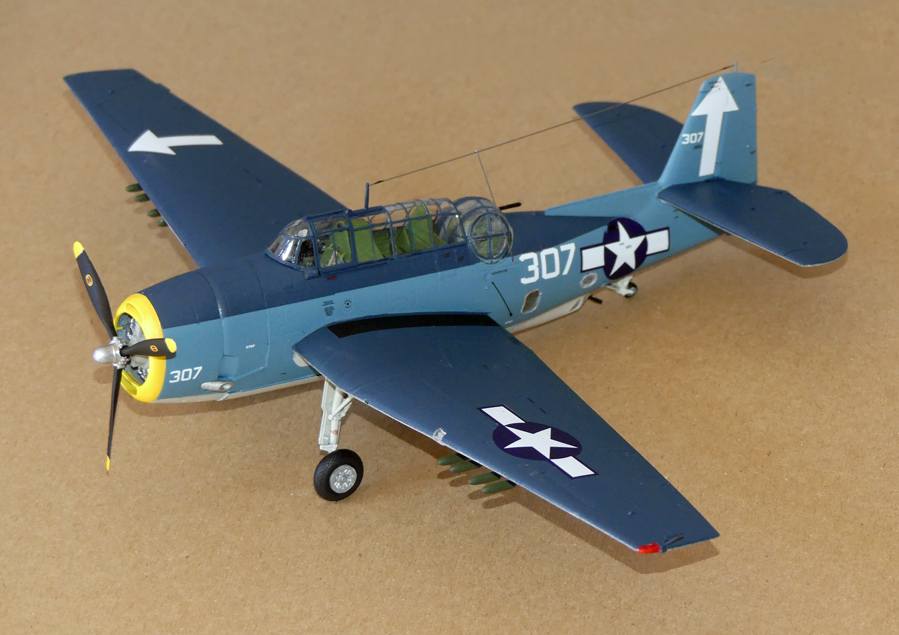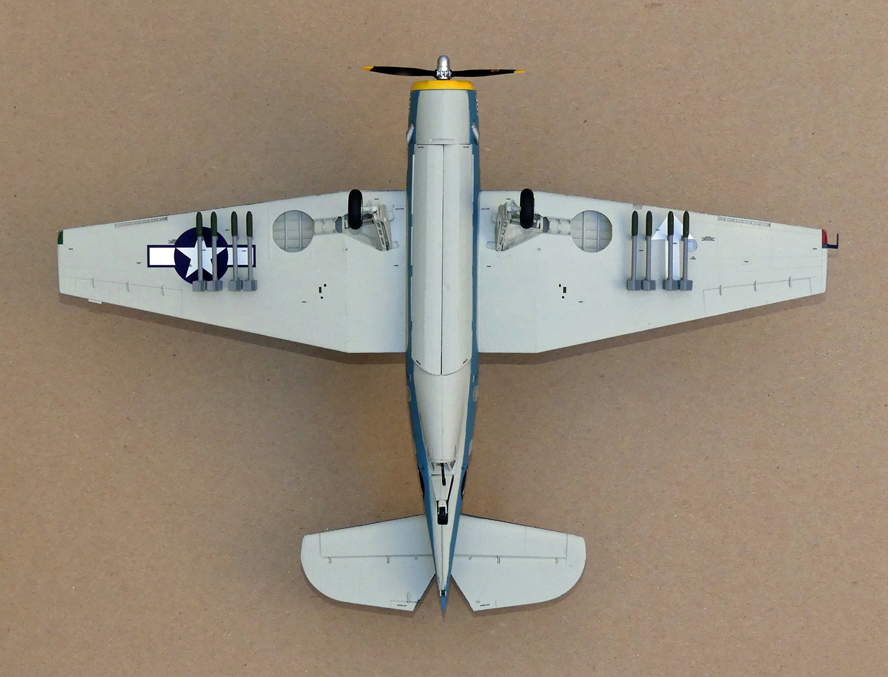
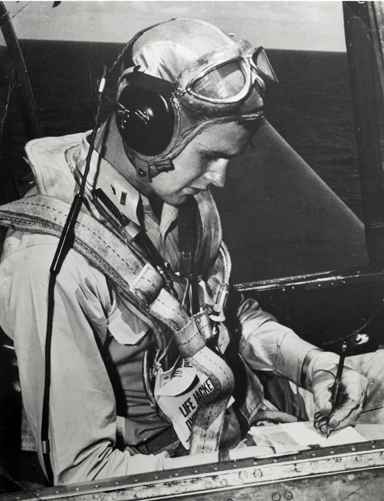
George H. W. Bush in a TBM Avenger, 1944


George H. W. Bush in a TBM Avenger, 1944
The Grumman TBF Avenger (designated TBM for aircraft manufactured by General Motors) is an American torpedo bomber developed initially for the United States Navy and Marine Corps, and eventually used by several air and naval aviation services around the world.
The Avenger was the heaviest single-engined aircraft of World War II, and only the USAAF's P-47 Thunderbolt came close to equaling it in maximum loaded weight among all single-engined fighters, being only some 400 pounds (180 kg) lighter than the TBF, by the end of World War II. To ease carrier storage concerns, simultaneously with the F4F-4 model of its Wildcat carrier fighter, Grumman designed the Avenger to also use the new Sto-Wing patented "compound angle" wing-folding mechanism, intended to maximize storage space on an aircraft carrier; the Wildcat's replacement, the F6F Hellcat, also employed this mechanism. The engine used was the twin-row Wright R-2600-20 Twin Cyclone fourteen-cylinder radial engine, which produced 1,900 horsepower (1,420 kW).
The Avenger had three crew members: pilot, turret gunner and radioman/bombardier/ventral gunner. A single synchronized .30 caliber (7.62 mm) machine gun was mounted in the nose, a .50 caliber (12.7 mm) gun was mounted right next to the turret gunner's head in a rear-facing electrically powered turret, and a single 0.30 caliber (7.62 mm) hand-fired machine gun flexibly-mounted ventrally (under the tail), which was used to defend against enemy fighters attacking from below and to the rear. This gun was fired by the radioman/bombardier while standing up and bending over in the belly of the tail section, though he usually sat on a folding bench facing forward to operate the radio and to sight in bombing runs. Later models of the TBF/TBM omitted the cowl-mount synchronized 0.30 caliber (7.62 mm) gun, and replaced it with twin Browning AN/M2 0.50 caliber (12.7 mm) light-barrel guns, one in each wing outboard of the propeller arc, per pilots' requests for better forward firepower and increased strafing ability.
There was only one set of controls on the aircraft, and no direct access to the pilot's position existed from the rest of the aircraft's interior. The radio equipment was massive, especially by today's standards, and filled the length of the well-framed "greenhouse" canopy to the rear of the pilot. The radios were accessible for repair through a "tunnel" along the right hand side. Any Avengers that are still flying today usually have an additional rear-mounted seat in place of the radios, allowing for a fourth passenger.
The Avenger had a large bomb bay, allowing for one Bliss-Leavitt Mark 13 torpedo, a single 2,000-pound (907 kg) bomb, or up to four 500-pound (227 kg) bombs. The aircraft had overall ruggedness and stability, and pilots say it flew like a truck, for better or worse. With its good radio facilities, docile handling, and long range, the Grumman Avenger also made an ideal command aircraft for Commanders, Air Group (CAGs). With a 30,000 ft (9,000 m) ceiling and a fully loaded range of 1,000 miles (1,600 km), it was better than any previous American torpedo bomber, and better than its Japanese counterpart, the obsolete Nakajima B5N "Kate". Later Avenger models carried radar equipment for the ASW and AEW roles.
The Avenger entered U.S. service in 1942, and first saw action during the Battle of Midway. Despite the loss of five of the six Avengers on its combat debut, it survived in service to become the most effective and widely-used torpedo bomber of World War II, sharing credit for sinking the super-battleships Yamato and Musashi (the only ships of that type sunk exclusively by American aircraft while under way) and being credited for sinking 30 submarines. Escort carrier sailors referred to the TBF as the "turkey" because of its size and maneuverability in comparison to the F4F Wildcat fighters in the same airgroups.
In June 1943, shortly before his 19th birthday, future-President George H. W. Bush was commissioned as the youngest naval aviator at the time. Later, while flying a TBM with VT-51 (from USS San Jacinto), his Avenger was shot down on 2 September 1944 over the Pacific island of Chichi Jima. However, he released his payload and hit the radio tower target before being forced to bail out over water. Both of his crewmates died. He was rescued at sea by the American submarine USS Finback. He later received the Distinguished Flying Cross.
Another famous Avenger aviator was Paul Newman, who flew as a rear gunner. He had hoped to be accepted for pilot training, but did not qualify because he was color blind. Newman was on board the escort carrier USS Hollandia roughly 500 mi (800 km) from Japan when the Enola Gay dropped the first atomic bomb on Hiroshima.
A famous incident involving TBM Avenger aircraft was the disappearance of Flight 19, a training flight of five Avengers that originated from Naval Air Station Fort Lauderdale and was lost on December 5, 1945 over the Bermuda Triangle. All 14 airmen on the flight were lost, as were all 13 crew members of a Martin PBM Mariner flying boat that subsequently launched from Naval Air Station Banana River to search for Flight 19.
During an airshow on 17 April 2021, TBM #91188 made a successful water landing south of Cocoa Beach, Florida near Patrick Space Force Base, in shallow surf. Valiant Air Command, the group that owns the plane, recovered the TBM for transport to Titusville, Florida, for extensive repairs. You can view the video: here.
Facts and General Characteristics of the TBM-3 Avenger:
Contractor: Grumman Corporation, built by General Motors
Type: Torpedo Bomber
Crew: Three (pilot, turret gunner and radioman/bombardier/ventral gunner).
Wingspan: 54 ft. 2 in. (16.5 m)
Length: 40 ft. (12.2 m)
Height: 16 ft. 5 in. (5.0 m)
Gross Weight: 15,536 lbs. (7,047 kg)
Power Plant: 1 × Wright R-2600-8 Twin Cyclone 14-cylinder air-cooled radial piston engine, 1,700 hp (1,300 kW)
Max Speed: 278 mph (447 km/h)
Ceiling: 22,600 ft. (6,900 m)
Range: 905 mi. (1,456 km) at cruise speed
Armament:
Guns:
1 × 0.30 in. (7.62 mm) nose-mounted M1919 Browning machine gun (on early models) or 2 × 0.50 in. (12.7 mm) wing-mounted M2 Browning machine guns.
1 × 0.50 in. (12.7 mm) dorsal-mounted M2 Browning machine gun.
1 × 0.30 in. (7.62 mm) ventral-mounted M1919 Browning machine gun
Rockets:
Up to eight 3.5” (89 mm) Forward Firing Aircraft Rockets, 5” (127 mm) Forward Firing Aircraft Rockets or High Velocity Aerial Rockets.
Bombs:
Up to 2,000 lbs. (907 kg) of bombs or 1 × 2,000 lb. (907 kg) Mark 13 torpedo or Mark 24 mine (Fido) acoustic homing torpedo.
Number Built (all variants): 9,839
Number Still Airworthy: 40
Facts and General Characteristics of the Model:
The model has the paint scheme and markings of a TBM-3 Avenger #307 assigned to Torpedo Squadron (VT) 84, Carrier Air Group (CVG) 84, USS Bunker Hill (CV-17), showing its tail markings ("G" symbol) in the first half of 1945. The bomb bay holds four 500-pound (227 kg) bombs.
Model Manufacturer: Academy Plastic Model Co., LTD., South Korea
Scale: 1/48
Wingspan: 13.3”
Length: 9.9”
Height: 3.9"”
Parts: 118
Decals: 91
Hours to build and paint: 51
Mistakes/problems:
1. A few parts of the instructions were ambiguous so I had to guess how a few parts went together.
2. Many of the parts did not fit will. I filed, sanded and filled in some but there are still visible gaps around the canopies and bomb bay doors.
3. I had to mask and paint the top gun turret and then place it in the fuselage before painting the fuselage. I tried to mask the whole turret when spay painting the fuselage but the tape I used did not hold well which resulted in overspray on the turret.
4. I left the bomb bay doors closed as it was too difficult to display them in the open unfolded position.
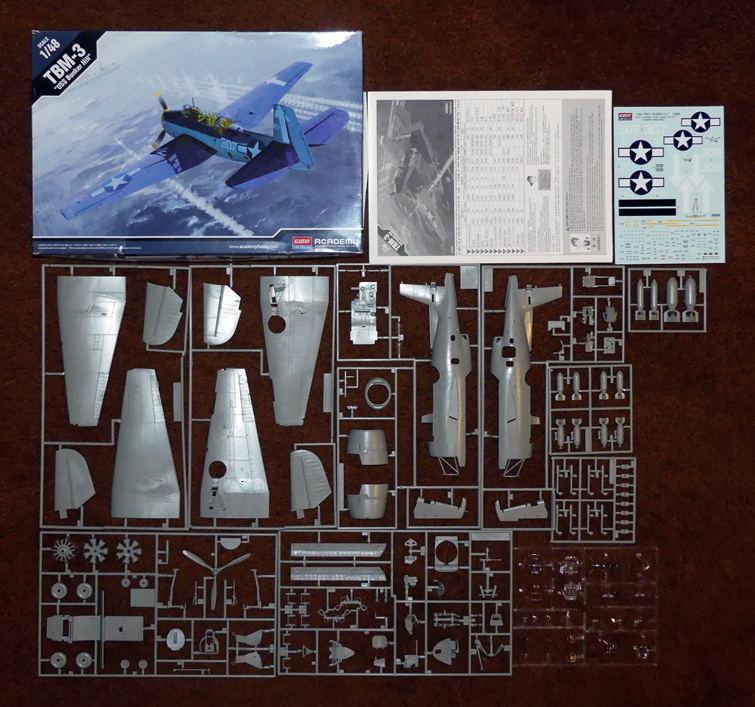

Notice the tailhook is stowed inside the fuselage for flight.
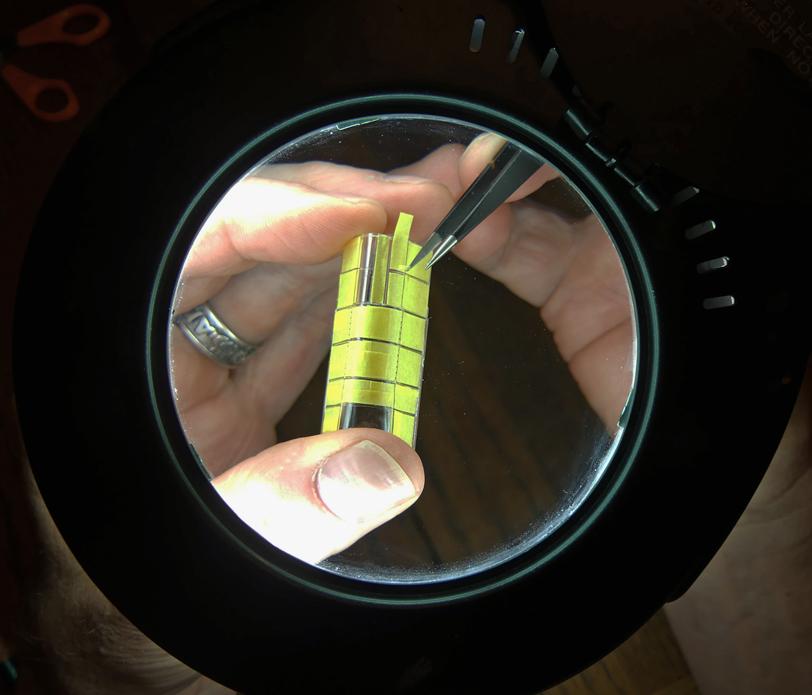
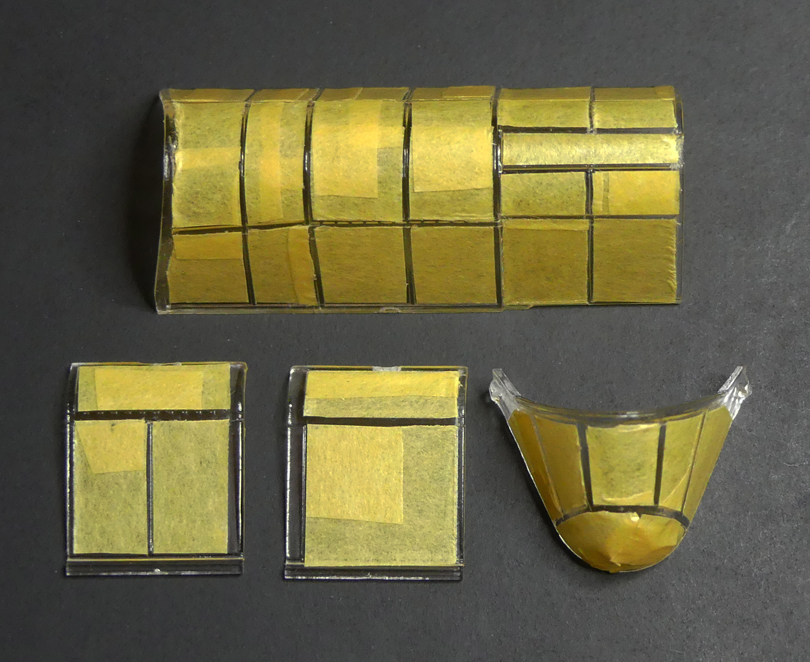
This took about four hours of trial and error.
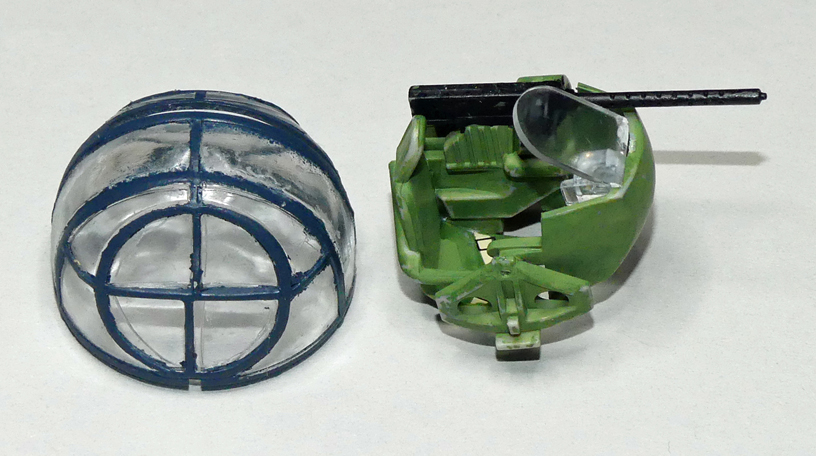
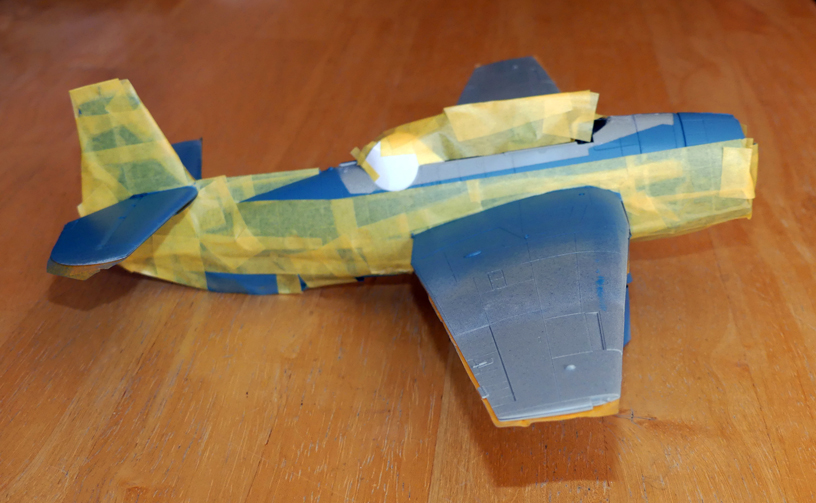
Ready for the third color: Navy Blue.
